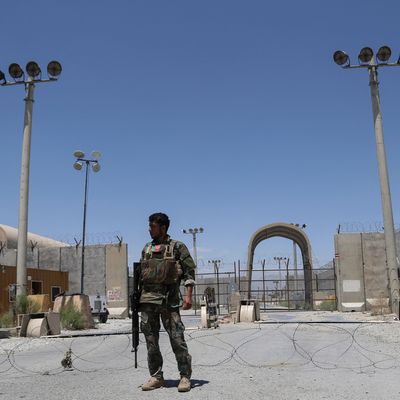
The U.S. handed over its most important military base in Afghanistan, Bagram Airfield, to Afghan forces on Friday, marking a symbolic moment amid the withdrawal of U.S. forces from the country after a nearly 20-year war against Taliban fighters. The evacuation of Bagram means that the withdrawal will likely be completed well ahead of the September 11 deadline set by President Biden and may be finished within days.
Bagram, located 45 miles north of Kabul, was originally constructed in the 1950s by the Soviet Union, which later used it as its main base of operations for ten years following its invasion of the country in 1979. After the U.S. invaded in 2001, it rebuilt, refortified, and expanded the then-ruined base and used it as its primary airfield throughout the war. More than 100,000 American service members passed through the base over the past two decades, and at the height of the war, Bagram was a city unto itself, as the Washington Post underlined Friday, the epicenter of the American war effort:
The transfer to Afghan forces was completed with no ceremony or fanfare, in a remarkably quiet end at a base that was for years the nerve center in its counterterrorism campaign across Afghanistan. Fighter jets, drones and cargo planes took off from Bagram’s twin runways day and night as U.S. Special Operations troops based there hunted al-Qaeda, the Islamic State and other militant groups in raids in Afghanistan’s rugged mountains to the east. Each of the previous three U.S. presidents visited the airfield during visits to Afghanistan.
The transfer of Bagram may not have gone very smoothly, however, according to Afghan military officials who spoke with the Associated Press. According to General Mir Asadullah Kohistani, the new commander at Bagram, the U.S. shut off the electricity and left overnight Thursday without any coordination with local authorities, which allowed looters to briefly enter the base on Friday morning before Afghan forces regained control. (A Pentagon official insisted that all handovers of U.S. coalition bases “have been closely coordinated” with Afghan leaders and forces.)
It’s not clear exactly how many U.S. service members still remain in Afghanistan or where, as the AP points out:
As of this week, most other NATO soldiers have already quietly exitedAfghanistan. Announcements from several countries analyzed by the AP show that a majority of European troops has left with little ceremony — a stark contrast to the dramatic and public show of force and unity when NATO allies lined up to back the U.S. invasion in 2001.
The U.S. has refused to say when the last American soldier would leave Afghanistan, citing security concerns, but also future security and protection for Kabul International Airport is still being negotiated. Turkish and U.S. soldiers are currently protecting the airport, still under Resolute Support Mission, which is the military mission being wound down.
Some 650 U.S. troops are also expected to remain in the country after the withdrawal to protect the American Embassy in Kabul. From now on, U.S. air support for Afghan forces and surveillance flights will either fly in from U.S. bases in the Gulf or from an aircraft carrier in the Arabian Sea. The U.S. has also committed almost $4 billion a year until 2024 to fund Afghan security forces.
But while the U.S. withdraws, the Taliban have been making significant gains across the country and may soon resume control, as the New York Times reports:
Some U.S. intelligence estimates predict that the Afghan government could fall to its rivals, the Taliban, in as little as six months after the Americans complete their withdrawal. The Taliban are inching closer to Kabul after having taken about a quarter of the country’s districts in the past two months.
Hundreds if not thousands of members of the Afghan security forces have surrendered in recent weeks, while their counterattacks have taken back little territory from the Taliban. And as the Afghan forces fracture, regional militias have appeared with renewed prominence, in an echo of the country’s path toward civil war in the 1990s.
Earlier this week, the top U.S. commander in the Afghanistan acknowledged that the threat of civil war was “certainly a path that can be visualized” in the country’s near future, adding, “that should be of concern to the world.”






























